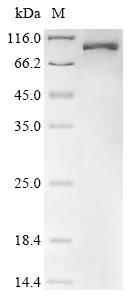Recombinant Human Lysyl oxidase homolog 3 (LOXL3)
CAT:
399-CSB-EP013042HU-02
Size:
100 µg
Price:
Ask
- Availability: 24/48H Stock Items & 2 to 6 Weeks non Stock Items.
- Dry Ice Shipment: No




Recombinant Human Lysyl oxidase homolog 3 (LOXL3)
- CAS Number: 9000-83-3
- Gene Name: LOXL3
- UniProt: P58215
- Expression Region: 26-753aa
- Organism: Homo sapiens
- Target Sequence: SPSPSTGPEKKAGSQGLRFRLAGFPRKPYEGRVEIQRAGEWGTICDDDFTLQAAHILCRELGFTEATGWTHSAKYGPGTGRIWLDNLSCSGTEQSVTECASRGWGNSDCTHDEDAGVICKDQRLPGFSDSNVIEVEHHLQVEEVRIRPAVGWGRRPLPVTEGLVEVRLPDGWSQVCDKGWSAHNSHVVCGMLGFPSEKRVNAAFYRLLAQRQQHSFGLHGVACVGTEAHLSLCSLEFYRANDTARCPGGGPAVVSCVPGPVYAASSGQKKQQQSKPQGEARVRLKGGAHPGEGRVEVLKASTWGTVCDRKWDLHAASVVCRELGFGSAREALSGARMGQGMGAIHLSEVRCSGQELSLWKCPHKNITAEDCSHSQDAGVRCNLPYTGAETRIRLSGGRSQHEGRVEVQIGGPGPLRWGLICGDDWGTLEAMVACRQLGLGYANHGLQETWYWDSGNITEVVMSGVRCTGTELSLDQCAHHGTHITCKRTGTRFTAGVICSETASDLLLHSALVQETAYIEDRPLHMLYCAAEENCLASSARSANWPYGHRRLLRFSSQIHNLGRADFRPKAGRHSWVWHECHGHYHSMDIFTHYDILTPNGTKVAEGHKASFCLEDTECQEDVSKRYECANFGEQGITVGCWDLYRHDIDCQWIDITDVKPGNYILQVVINPNFEVAESDFTNNAMKCNCKYDGHRIWVHNCHIGDAFSEEANRRFERYPGQTSNQII
- Tag: N-terminal 10xHis-tagged and C-terminal Myc-tagged
- Source: E.coli
- Field of Research: Signal Transduction
- Assay Type: In Stock Protein
- Relevance: Protein-lysine 6-oxidase that mediates the oxidation of peptidyl lysine residues to allysine in target proteins. Catalyzes the post-translational oxidative deamination of peptidyl lysine residues in precursors of elastin and different types of collagens, a prerequisite in the formation of cross-links between collagens and elastin. Required for somite boundary formation by catalyzing oxidation of fibronectin (FN1), enhancing integrin signaling in myofibers and their adhesion to the myotendinous junction (MTJ). Acts as a regulator of inflammatory response by inhibiting differentiation of naive CD4 (+) T-cells into T-helper Th17 or regulatory T-cells (Treg): acts by interacting with STAT3 in the nucleus and catalyzing both deacetylation and oxidation of lysine residues on STAT3, leading to disrupt STAT3 dimerization and inhibit STAT3 transcription activity. oxidation of lysine residues to allysine on STAT3 preferentially takes place on lysine residues that are acetylated. Also able to catalyze deacetylation of lysine residues on STAT3. ; [Isoform 1]: Shows protein-lysine 6-oxidase activity toward elastin and different types of collagens, with the highest activity toward collagen type VIII. ; [Isoform 2]: Shows protein-lysine 6-oxidase activity toward elastin and different types of collagens, with the highest activity toward collagen type IV.
- Purity: Greater than 90% as determined by SDS-PAGE.
- Activity: Not Test
- Length: Full Length of Mature Protein
- Form: Liquid or Lyophilized powder
- Buffer: If the delivery form is liquid, the default storage buffer is Tris/PBS-based buffer, 5%-50% glycerol. If the delivery form is lyophilized powder, the buffer before lyophilization is Tris/PBS-based buffer, 6% Trehalose, pH 8.0.
- Reconstitution: We recommend that this vial be briefly centrifuged prior to opening to bring the contents to the bottom. Please reconstitute protein in deionized sterile water to a concentration of 0.1-1.0 mg/mL.We recommend to add 5-50% of glycerol (final concentration) and aliquot for long-term storage at -20℃/-80℃. Our default final concentration of glycerol is 50%. Customers could use it as reference.
- Molecular Weight: 87.8 kDa
- References & Citations: "Lysyl oxidase 3 is a dual-specificity enzyme involved in STAT3 deacetylation and deacetylimination modulation." Ma L., Huang C., Wang X.J., XIn D.E., Wang L.S., Zou Q.C., Zhang Y.S., Tan M.D., Wang Y.M., Zhao T.C., Chatterjee D., Altura R.A., Wang C., Xu Y.S., Yang J.H., Fan Y.S., Han B.H., Si J. Chin Y.E. Mol. Cell 65:296-309 (2017)
- Storage Conditions: The shelf life is related to many factors, storage state, buffer ingredients, storage temperature and the stability of the protein itself. Generally, the shelf life of liquid form is 6 months at -20℃/-80℃. The shelf life of lyophilized form is 12 months at -20℃/-80℃.
